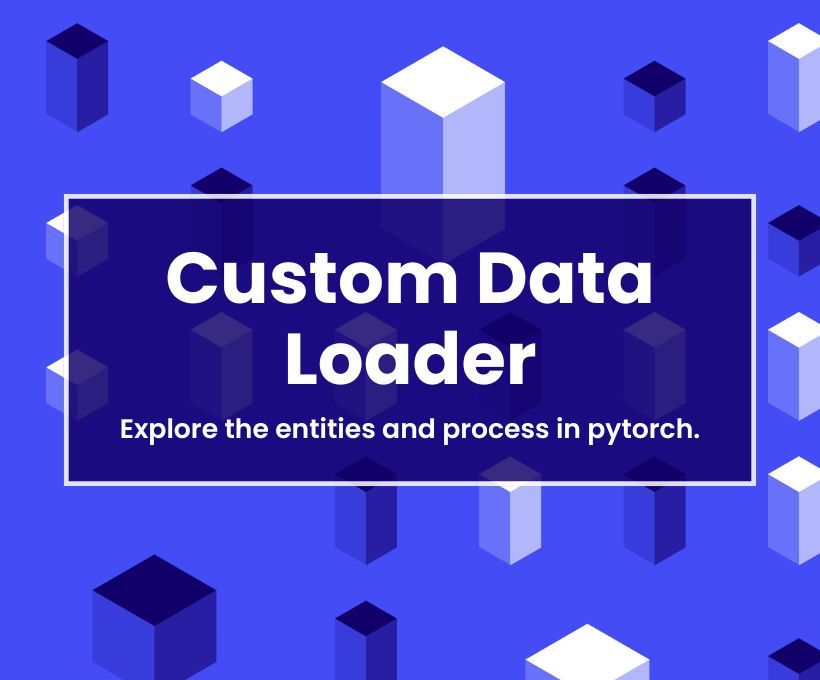Table of Contents:
- Introduction to Custom Data Loaders
- Key Components of a Custom Data Loader
- How Custom Data Loaders Work
- Dataset Representation vs. Loading Data
- Practical Example: Working with Image Data
- Conclusion
Introduction
Data loading is a critical step in training machine learning models. In PyTorch, custom data loaders offer flexibility, scalability, and efficiency, enabling developers to handle diverse datasets. This blog post delves into the key components of custom data loaders, their working principles, and the distinction between dataset representation and loading data.
Key Components of a Custom Data Loader
When working with custom data loaders in PyTorch, there are three key components to understand—one mandatory and two optional:
1. Dataset (Mandatory):
- The dataset is an abstraction that represents the entire data but does not necessarily load all of it into memory at once.
- To create a custom dataset, you define a class that inherits from PyTorch’s
Datasetclass and implement two essential methods:__len__: Returns the total number of data samples.__getitem__: Retrieves a single data sample based on its index.- This design provides a systematic and memory-efficient way to interact with large datasets.
2. Data Loader (Optional):
- The
DataLoaderhandles the job of loading data from the dataset representation. It provides features like:- Loading data in batches.
- Shuffling data for randomness in training.
- Parallel data loading using multiple workers for better performance.
- It bridges the gap between dataset representation and training by efficiently managing data fetching.
- You may think that this is mandatory, not optional, but that’s not true. We can load the data without DatasetLoader using a loop on the instance of our dataset.
3. Transformer (Optional):
- Transformers are used to preprocess or augment the data, making it ready for training.
- Common transformations include resizing, normalizing, flipping, and cropping images.
- They enhance model robustness and improve training efficiency.
How Custom Data Loaders Work
The process of using a custom data loader in PyTorch involves the following steps:
- Creating a Dataset Representation:
- Define a custom dataset class that specifies how to access individual samples and provides the total number of samples.
- Loading Data in Batches:
- Use the
DataLoaderto fetch data in manageable batches, shuffle it, and prepare it for processing.
- Use the
- Augmenting/Transforming Data (Optional):
- Apply preprocessing or augmentation to each sample or batch to improve the model’s ability to generalize.
- Passing Data to the Model:
- Once the data is prepared, pass it to the model for training or validation.
Dataset Representation vs. Loading Data
Understanding the distinction between dataset representation and loading data is crucial for effective use of custom data loaders. Here’s a breakdown:
| Aspect | Dataset Representation | Loading Data |
|---|---|---|
| Definition | Logical structure to describe data access. | Actual process of fetching data into memory. |
| Memory Usage | Minimal, only stores references or metadata. | Requires memory to store fetched data (e.g., batch). |
| Implementation | Implemented via Dataset in PyTorch. | Implemented via DataLoader in PyTorch. |
| When Accessed | Defines the “how” of data retrieval. | Brings data samples for use (training/validation). |
| Example | List of file paths for images. | Actual image tensors loaded in memory. |
In simple terms:
- Dataset Representation: Think of it as a blueprint or catalog that outlines what data is available and how to retrieve it.
- Loading Data: This is the act of fetching actual data (e.g., image tensors or text) from the source into memory.
By separating these two responsibilities, PyTorch ensures scalability and efficiency, even with extremely large datasets.
Example Use Case: Working with Image Data (Without Transformations)
Here’s a practical example of how to load image data without transformations using a custom data loader. We’re treating the image index (in the directory) as its target label y:
import os
from torch.utils.data import Dataset, DataLoader
from PIL import Image
# Custom Dataset
class CustomImageDataset(Dataset):
def __init__(self, image_dir):
self.image_dir = image_dir
self.image_files = os.listdir(image_dir)
def __len__(self):
return len(self.image_files)
def __getitem__(self, idx):
image_path = os.path.join(self.image_dir, self.image_files[idx])
image = Image.open(image_path).convert("RGB")
return image, self.image_files[idx]
# Define paths and load data
image_dir = "path_to_images"
dataset = CustomImageDataset(image_dir)
dataloader = DataLoader(dataset, batch_size=4, shuffle=True)
# Iterating through the DataLoader
for batch_idx, (images, filenames) in enumerate(dataloader):
print(f"Batch {batch_idx}: {filenames}")
Conclusion
Custom data loaders in PyTorch provide a powerful way to manage datasets, from simple numerical data to large-scale image collections. By understanding the roles of dataset representation, data loading, and transformations, you can efficiently handle complex workflows while keeping memory usage optimal.
By separating the concepts of representation and loading, PyTorch empowers developers to train models on massive datasets without compromising scalability or performance. Mastering these fundamentals is an essential step for anyone serious about machine learning and deep learning.
Feel free to share your thoughts or ask questions in the comments below. If you found this helpful, consider referring fellow learners to this post!
